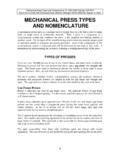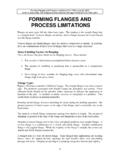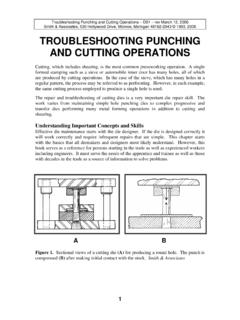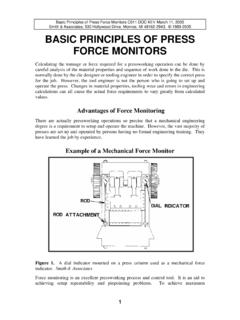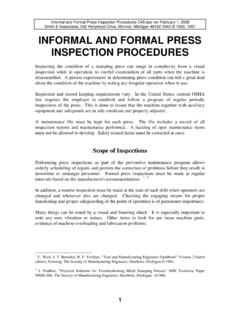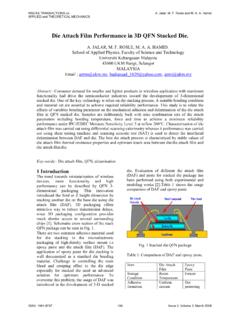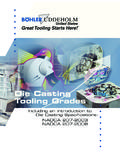Transcription of Die Materials & Treatments - Smith & Associates
1 Die Materials and Treatments Rev September 1, 2005 1993, 2005 David Alkire Smith , 530 Hollywood Drive, Monroe, Michigan 48162-2943 DIE Materials AND Treatments Tool steels are used to construct the die components subject to wear. They are used in a variety of pressworking operations. These steels are designed especially to develop high hardness levels and abrasion resistance when The plain carbon and low-alloy steels are readily machinable and weldable. These low cost steels are used for machine parts, keys, bolts, retainers, and for support tooling. Cast-steel dies are used for large drawing and forming dies where maximum impact toughness is required. At carbon levels of and higher, cast-alloy-steel dies can be effectively flame-hardened at points of wear. Cast irons are a plural term for cast iron because many different compositions having special properties are used for shoes, plates, dies, adapters and other large components.
2 Die irons are often alloyed to permit flame hardening when used for the wear surfaces of large sheet metal drawing and forming dies. The ductile (nodular) irons retain the casting advantages of cast iron, while having toughness, stiffness and strength levels approaching those of steel. In addition to ferrous die Materials , varieties of die components are made of non-ferrous metals such as zinc and copper alloys. Elastomer products find widespread application as die pads, rubber springs and automation components. Even wood and wood fiber products are used for low-cost dies. Characteristics of Tool and Die Steels The steels listed in Table 1 are used in the great majority of the metal-stamping operations. The list contains 27 steels, which are available from many tool steel sources. Some of these steels have slight variations for improved performance under certain conditions. 2 1 D.
3 Jarvis, Metallurgy of Tool Steels, sponsored by the Society of Manufacturing Engineers Livonia, Michigan May 3-4 2000. 2 D. Smith , Die Design Handbook, Third Edition, Section 28, Ferrous Die Materials , the Society of Manufacturing Engineers, Dearborn, Michigan, 1990. Rod Denton, Late President and Timothy Zemaitis, Metallurgical Engineer, Sun Steel Treating Inc., South Lyon, Michigan graciously assisted in editing the material in the Third Edition of the Die Design Handbook is work for technical content. 1 Die Materials and Treatments Rev September 1, 2005 1993, 2005 David Alkire Smith , 530 Hollywood Drive, Monroe, Michigan 48162-2943 AISI Nominal Steel Composition Percent Type C Mn Si W Cr Mo V Other W1 W2 O1 O2 O6 A2 A8 A9 Ni D2 D3 D4
4 D7 S1 S5 S7 T1 T15 Co M1 M2 M4 M7 M42 Co H12 H13 H21 H26 L6 Ni W - Water Hardening D - High Carbon, High Chromium Die Steels O - Oil Hardening S - Shock Resisting A - Air Hardening T - Tungsten Base, High Speed H - Hot Working M - Molybdenum-base High Speed L - Special Purpose, Low-alloy Table 1.
5 Readily available tool and die steels. Sun Steel Treating 2 Die Materials and Treatments Rev September 1, 2005 1993, 2005 David Alkire Smith , 530 Hollywood Drive, Monroe, Michigan 48162-2943 AISI-SAE letter and number designations identify the steels in this list. The letter represents the group of the steel involved. The number indicates a separation of one grade or type from another. The use of standard industry identification is encouraged rather than shop jargon and trade names to describe the steels. Some highly alloyed steels made by the powdered metallurgy process rather than cast ingots produce a product of uniform composition and grain structure. This process permits the high volume production of tool steels that would be very difficult to make in any other way. Choosing Tool Steels The wise choice of tool steels is important when dies are designed in order to insure good wear performance.
6 Specifying more costly tool steel than is justified by die wear requirements is wasteful. Expensive die details should be designed for long wear. Likewise, die parts that wear rapidly requiring downtime for replacement and high repair costs should be designed for good wear resistance. The die repair activity should carefully track die repair costs as an aid to achieving the most cost effective tooling material and processing methods. This information should be used to update the die standards for each type of tooling. In this way, tooling dependability can be continuously improved and costs minimized. W, Water-hardening Tool Steels W1 and W2 are both readily available and low in cost. W2 contains vanadium, which provides a finer grain size attended by lower hardenability and higher toughness. Both are shallow hardening. In large sections, this results in a hard case and a softer internal core, having high toughness.
7 Closely controlling the vanadium content helps assure a more closely level of hardenability, especially when compared to W1. They are quenched in water or brine and are subject to substantial size changes when heat-treated. In the past, these steels were more popular than at present because of low cost and were widely used for short to medium run tooling. They are still a good choice for a variety of applications where cost is a prime factor such as short run automotive applications. Automotive body panel dies seldom exceed one million pieces per model year. O, Oil-hardening Tool Steels Steels O1 and O2 were once the workhorses of the industry. These are known as manganese oil-hardening steels. They are readily available and low in cost. These steels, which are normally quenched in oil, have less size change than the water-hardening steels. Compared to the water hardening steels, they are easier to harden throughout the workpiece and are at least equally tough.
8 Type O6, which contains free graphite, has excellent machinability. 3 Die Materials and Treatments Rev September 1, 2005 1993, 2005 David Alkire Smith , 530 Hollywood Drive, Monroe, Michigan 48162-2943 AISI Steel Type Preheat Temperature Rate of Heating For Hardening Hardening Temperature Degrees Minimum Time at Temperature, Minutes Quenching Medium W1 1200 /1250 F 649 /677 C Slow 1425 /1500 F 774 /816 C 15 min. Brine or Water W2 1200 /1250 649 /677 C Slow 1425 /1500 F 774 /816 C 15 min. Brine or Water O1 1200 /1250 649 /677 C Slow 1450 /1500 F 788 /816 C 15 min. Warm Oil O2 1200 /1250 F 649 /677 C Slow 1400 /1475 F 760 /802 C 15 min. Warm Oil O6 1200 /1250 649 /677 C Slow 1450 /1500 F 788 /816 C 30 min.
9 Warm Oil A2 1450 /1500 F 788 /816 C Slow 1725 /1800 F 982 /1,010 C 30 min. Air, Salt, Oil A8 1450 /1500 F 788 /816 C Slow 1800 /1850 F 788 /816 C 30 min. Air, Salt, Oil A9 1450 /1500 F 788 /816 C Slow 1800 /1850 F 982 /1,010 C 30 to 60 min. Salt, Air D2 1450 /1500 F 788 /816 C Slow 1800 /1875 F 982 /1,024 C 30 min. Salt, Air D3 1450 F 788 C Slow 1750 F 30 min. Warm Oil D4 1450 /1500 F 788 /816 C Slow 1800 /1850 F 30 min. Air, Salt, Oil D7 1450 F 788 C Slow 1875 /2000 F 45 min. Air, Oil S1 1400 F 760 C Slow 1700 /1750 F 15-20 min.
10 Salt, Warm Oil S5 1250 F 677 C Slow 1550 /1650 F 15-20 min. Salt, Oil, Water S7 1200 /1300 F 649 /704 C Slow 1725 /1750 F 20 min. Oil, Salt T1 1500 /1600 F 816 /871 C Quickly from preheat 2100 /2350 F 3-7 min. Salt, Warm Oil T15 1450 /1550 F 788 /843 C Quickly from preheat 2175 /2275 F 3-5 min. Salt, Warm Oil M1 1500 /1550 F 816 /843 C Quickly from preheat 2150 /2225 F 2-5 min. Salt, Warm Oil M2 1500 /1550 F 816 /843 C Quickly from preheat 2175 /2275 F 3-7 min. Salt, Warm Oil M4 1500 /1550 F 816 /843 C Quickly from preheat 2150 /2250 F 3-7 min. Salt, Warm Oil M7 1500 /1550 F 816 /843 C Quickly from preheat 2175 /2225 F 3-7 min. Salt, Warm Oil M42 1500 /1550 F 816 /843 C Quickly from preheat 2150 /2200 F 3-7 min.
